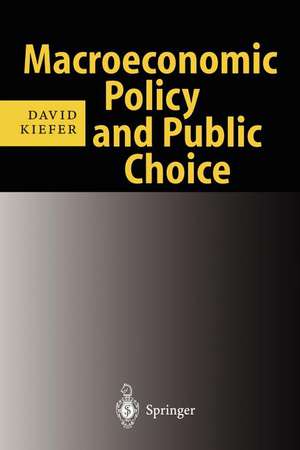Macroeconomic Policy and Public Choice
Autor David Kieferen Limba Engleză Paperback – 18 noi 1998
Preț: 641.38 lei
Preț vechi: 754.56 lei
-15% Nou
Puncte Express: 962
Preț estimativ în valută:
122.75€ • 127.17$ • 102.44£
122.75€ • 127.17$ • 102.44£
Carte tipărită la comandă
Livrare economică 21 martie-04 aprilie
Preluare comenzi: 021 569.72.76
Specificații
ISBN-13: 9783540648727
ISBN-10: 3540648720
Pagini: 272
Ilustrații: XVII, 275 p.
Dimensiuni: 155 x 235 x 14 mm
Greutate: 0.45 kg
Ediția:Softcover reprint of the original 1st ed. 1997
Editura: Springer Berlin, Heidelberg
Colecția Springer
Locul publicării:Berlin, Heidelberg, Germany
ISBN-10: 3540648720
Pagini: 272
Ilustrații: XVII, 275 p.
Dimensiuni: 155 x 235 x 14 mm
Greutate: 0.45 kg
Ediția:Softcover reprint of the original 1st ed. 1997
Editura: Springer Berlin, Heidelberg
Colecția Springer
Locul publicării:Berlin, Heidelberg, Germany
Public țintă
ResearchCuprins
1. A Historical Introduction.- 1.1. The Keynesian revolution and the evolution of government’s role.- 1.2. Keynesian orthodoxy.- 1.3. The political consequences of depression proofing.- 1.4. The economic consequences of depression proofing.- 1.5. Schools of thought.- 1.6. Ideology and politics.- 1.7. The market failure rationale for government intervention.- 1.8. Public choice.- 1.9. Conclusion.- 2. Microeconomic Foundations.- 2.1. Introduction.- 2.2. Consumers.- 2.3. Producers.- 2.4. General equilibrium.- 2.5. Pareto efficiency.- 2.6. Social welfare functions.- 2.7. Unemployment and inflation.- 2.8. The government budget and economic policy.- 2.9. Conclusion.- 3. Social Choice.- 3.1. Introduction.- 3.2. The theoretical superiority of majority rule.- 3.3. The impossibility of asking for more.- 3.4. Median voter model.- 3.5. Two dimensional social choice.- 3.6. Probabilistic voting.- 3.7. Political information and party ideology.- 3.8. Conclusion.- 4. Short-Run Macro Models.- 4.1. Introduction.- 4.2. Classical macro from micro foundations.- 4.3. Rationed equilibrium and rigid prices.- 4.4. Non-Walrasian equilibria.- 4.5. A Cobb-Douglas example.- 4.6. Conclusion.- 5. The Phillips Curve and Expectations.- 5.1. Introduction.- 5.2. The natural rate hypothesis.- 5.3. Unemployment and output gaps.- 5.4. Expectations about inflation in the future.- 5.5. Econometric uncertainty.- 5.6. One model of supply: Producer uncertainty.- 5.7. Another model: Predetermined wages.- 5.8. New classical macroeconomics.- 5.9. Conclusion.- 6. Fiscal and Monetary Policy.- 6.1. Introduction.- 6.2. Accounting peculiarities in the US budget.- 6.3. Built-in stabilizers.- 6.4. Balanced and unbalanced budgets.- 6.5. Doubts about fiscal policy effectiveness.- 6.6. The Federal Reserve and thePresident.- 6.7. Describing the money stock.- 6.8. Causality tests.- 6.9. Spurious regressions.- 6.10. Conclusion.- 7. Keynesian Business Cycles.- 7.1. Introduction.- 7.2. Cycles in a Keynesian model.- 7.3. A linear econometric model.- 7.4. Linear versus nonlinear models.- 7.5. Regression results.- 7.6. Econometric cautions.- 7.7. Dynamic behavior.- 7.8. Conclusion.- 8. Citizen Preferences.- 8.1. Introduction.- 8.2. Presidential popularity.- 8.3. Modeling popularity.- 8.4. Results.- 8.5. Conclusion.- 9. Endogenous Stabilization and Macroeconomic Ideology.- 9.1. Introduction.- 9.2. Endogenous stabilization policy.- 9.3. Ideology.- 9.4. Perceptions and expected utility.- 9.5. Plausible parameter values.- 9.6. The zero-inflation rule and inflation volatility.- 9.7. Voters should prefer conservatives, under certain conditions.- 9.8. Uncertainty about candidate platforms.- 9.9. Conclusion.- 10. Political Business Cycles.- 10.1. Introduction.- 10.2. Election opportunism.- 10.3. Partisan macroeconomics.- 10.4. Backward looking expectations.- 10.5. Forward looking expectations.- 10.6. Observations.- 10.7. Regression tests.- 10.8. Growth rate targets.- 10.9. Conclusion.- 11. Government Debt, Deficit and Social Security.- 11.1. Public debt in the short and long-run.- 11.2. Overlapping generations and efficiency.- 11.3. Public debt.- 11.4. Pay-as-you-go social security.- 11.5. Overlapping generations and equity.- 11.6. Market imperfections in the credit market.- 11.7. The Ricardian equivalence theorem.- 11.8. Illusions, inertia and irrationalities.- 11.9. Economic growth and the bequest constraint.- 11.10. Social security.- 11.11. Conclusion.- Appendix: More overlapping scenarios.- 12. Conclusion.- 12.1. The Keynesian revolution.- 12.2. Foundations.- 12.3. Weak evidence of policyeffectiveness.- 12.4. Rational expectations and the Phillips curve.- 12.5. An inherently unstable equilibrium.- 12.6. Stabilization and conservatism.- 12.7. Doubts about rational expectations.- 12.8. Long-run Keynesian outcomes.- References 241.- Subject Index 249.
Caracteristici
Revised and extended study edition of Kiefer`s successful book on the connections between macroeconomics and government politics


















